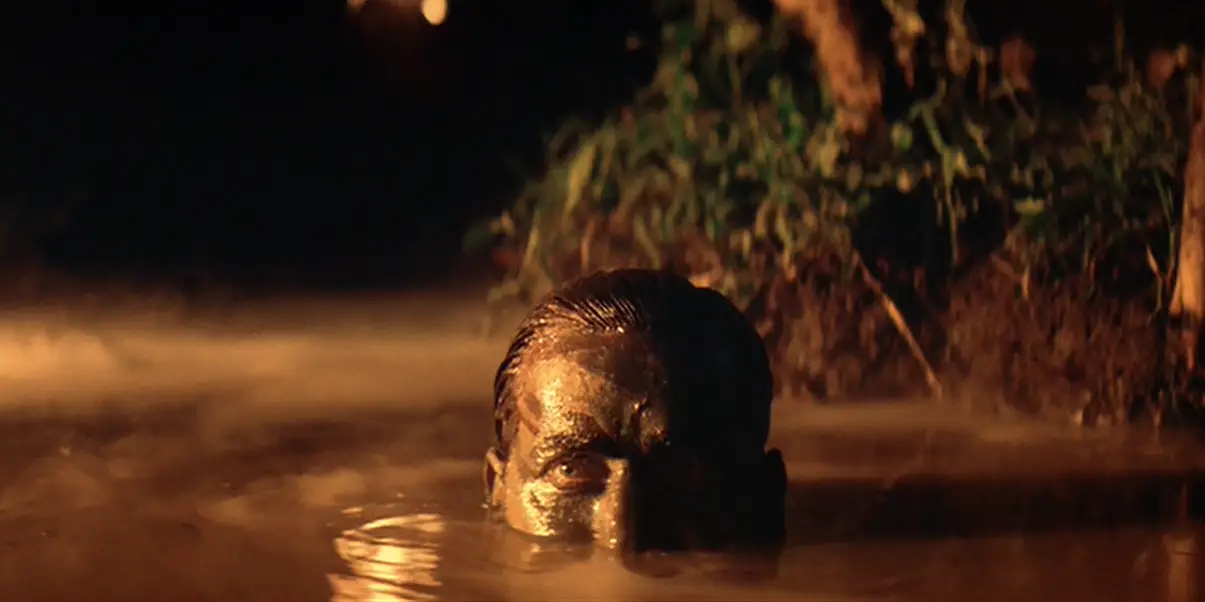
Director: Francis Ford Coppola
Producer: Francis Ford Coppola, Gray Frederickson, Fred Roos, Tom Sternberg
Writers: John Milius, Francis Ford Coppola, Michael Herr (screenplay), Joseph Conrad (novel)
Photography: Vittorio Storaro
Music: The Doors, Richard Wagner, The Rolling Stones, Carmine Coppola, Francis Ford Coppola
Cast: Martin Sheen, Marlon Brando, Robert Duvall, Frederic Forrest, Dennis Hopper, Sam Bottoms, Laurence Fishburne, Harrison Ford, Scott Glenn
![]()
Introduction
“My film isn’t about Vietnam. It is Vietnam. It’s what it was really like. It was crazy. And the way we made it was very much like the way the Americans were in Vietnam. We were in the jungle, there were too many of us, we had access to too much money, too much equipment and little by little we went insane.” (A)
No film is more linked to its “making of” story than Francis Ford Coppola’s Apocalypse Now. It should be required, like a Coppola wine pairing, to watch the film together with the fantastic behind-the-scenes documentary, Hearts of Darkness: A Filmmaker’s Apocalypse (1991), created by Coppola’s wife Eleanor, who recorded the director’s most personal fears throughout the “horror” of production.
It all started off innocent enough, with an acclaimed director bringing Hollywood’s biggest stars to the Philippines, where a young Sofia Coppola (future director of Lost in Translation) quipped, “It looks like the Disneyland jungle cruise.” (A) Then all hell broke loose. A massive typhoon named Olga wiped out the sets and shut down production for two months to rebuild. The Philippine government offered helicopters to use on set, but suddenly recalled them to fend off rebel forces. Martin Sheen suffered a near-fatal heart attack at the young age of 36, receiving last rites from a non-English speaking priest and being sidelined for five weeks.
If that wasn’t enough, Marlon Brando threatened to take his million dollars and run, annoyed at the production delays. While he ultimately agreed to stay, he showed up overweight without having read the film’s source novel, Joseph Conrad’s Heart of Darkness (1899). Dennis Hopper was stoned out of his mind and unable to remember his lines, and supporting actors like Sam Bottoms dropped acid and speed throughout the production. Perhaps most problematic was Coppola himself, who was filled with enough hubris after the success of the two Godfather films that he tried to tackle material that had licked even the great Orson Welles, who wound up doing Citizen Kane instead. (A)
The result was a shoot that ballooned from 16 weeks to three years (including 238 days of principal photography), ran up a cost of an additional $20 million, and, in many people’s eyes, signaled the complete draining of Coppola’s artistic ability. Watching Apocalypse, one can detect a giant last gasp of genius, captured on film just in time before it disappeared forever. Like countless vets, Coppola was never the same after he returned from his Vietnam experience. He had to mortgage his house, sell his assets to United Artists, and make severe edits to a film that concluded with an unfinished script and a maddeningly ambiguous ending. What remained, however, was a flawed masterpiece, winner of the world’s top art prize (the Palme d’Or at the 1979 Cannes Film Festival) but loser of the more mainstream version (the Academy Award for Best Picture). Apocalypse Now — and its “making of” story — thus gloriously exemplifies our Film Spectrum dilemma between artistic expression and commercial imperative, a dangerous tightrope walk best articulated by Brando’s Colonel Kurtz: “I watched a snail crawl along the edge of a straight razor.”
![]()
Script Drafts & Military Drafts
The epic film would attempt to lift Conrad’s allegorical river journey out of the jungles of the Congo and drop it into the jungles of the Vietnam War. The plot revolves around Army Captain Benjamin Willard (Martin Sheen), who receives a classified mission to assassinate a renegade U.S. commander, Colonel Kurtz (Marlon Brando), who has defected and started a cult at a remote outpost in Cambodia. With each stop along the way, Captain Willard himself moves one step closer to madness.
“When I was at cinema school … this war was raging on, and I thought this is an interesting place to have a war, a very colorful place to have a war,” screenwriter John Milius said. “I didn’t think much about me doing a movie about the war, because I figured I was going to go. … By being in school, I had a temporary deferment, but I knew that I was going to go, and I was sort of looking forward to it, because I really didn’t think I would ever have a career in the cinema. I thought I would have a military career — that would probably end shortly (in death).”
While at the University of Southern California, Milius met fellow undergraduate film student George Lucas, who would sit in a grassy area of the campus stable, rave about the movies they saw, from Dr. Strangelove (1964) to The Wild Bunch (1969), and swap stories about all the great movies they were going to make. One day, his professor touted Conrad’s Heart of Darkness as not only one of the best works of Western literature, but one that had stumped every great Hollywood screenwriter, from Ben Hecht (His Girl Friday) to Ernest Lehman (North By Northwest) to Orson Welles (Citizen Kane). Milius lit up: “That was like waving a red flag in front of a young bull.”
Then the idea dawned on Milius. He would use Heart of Darkness as an allegory for the Vietnam War. While he had read the novel years ago, he decided to not go back and read it again, because he wanted to remember the story more as a dream than a direct adaptation. Coppola gave Milius $15,000 to live off for a year to go off and write the script.
Milius returned with a work of screenwriting brilliance, which was only made better with rewrites from Coppola, who had won Best Screenplay on Patton (1970), and a dialogue polish by Michael Herr, who later earned an Oscar nomination for Full Metal Jacket (1987). The final product was voted No. 55 on the WGA’s Top 101 Screenplays of All Time, one slot ahead of Back to the Future (1985). It’s easy to see why. The script boasts some of the best voiceover narration in the history of cinema:
WILLARD: “Saigon… shit; I’m still only in Saigon… Every time I think I’m gonna wake up back in the jungle. When I was home after my first tour, it was worse. I’d wake up and there’d be nothing. I hardly said a word to my wife, until I said ‘yes’ to a divorce. When I was here, I wanted to be there; when I was there, all I could think of was getting back into the jungle. I’m here a week now… waiting for a mission… getting softer. Every minute I stay in this room, I get weaker, and every minute Charlie squats in the bush, he gets stronger. Each time I looked around the walls moved in a little tighter.”
WILLARD: “I was going to the worst place in the world and I didn’t even know it yet. Weeks away and hundreds of miles up a river that snaked through the war like a main circuit cable plugged straight into Kurtz. It was no accident that I got to be the caretaker of Colonel Walter E. Kurtz’s memory any more than being back in Saigon was an accident. There is no way to tell his story without telling my own. And if his story really is a confession, then so is mine.”
WILLARD: “He was close, real close. I couldn’t see him yet, but I could feel him, as if the boat were being sucked upriver and the water was flowing back into the jungle. Whatever was going to happen, it wasn’t gonna be the way they call it back in Nha Trang.”
Ironically, the film’s most famous bit of writing does not lie in voiceover narration, but rather on-screen from Colonel Kilgore (Robert Duvall): “I love the smell of napalm in the morning.” The line was voted the AFI’s No. 12 Movie Quote of All Time, but to truly appreciate it, you must consider the rest of the speech, ending with, “Someday this war’s gonna end.” Most sane folks would say this in reassuring hope that the bloodshed will soon be over. Not Kilgore. He says it with unfortunate sadness, as if saying “all good things must come to an end.” Now that’s truly frightening.
![]()
Finding a Director
With the script completed, the original plan was for Coppola to produce and for George Lucas to direct, which had been the case on both THX 1138 (1971) and American Graffiti (1973). While Milius wanted to shoot the film in Vietnam itself, Lucas had a different vision, wanting to shoot it in Stockton, California in black-and-white 16mm in a pseudo-documentary style like The Battle of Algiers (1966).
“He was going to do Apocalypse before Star Wars, but once he made American Graffiti, he got rich and didn’t want to make Apocalypse Now. He did not want to go where they have many different varieties of poisonous insects. He did not want to go to a place that rained everyday and was miserable and there were tigers,” Milius said of Lucas.
With Lucas out of the picture, Coppola offered the directing reins to Milius, who had made Dillinger (1973), starring Warren Beatty, but Milius was too busy directing his next project, The Wind and the Lion (1975), starring Sean Connery. With no other options, Coppola decided to direct the film himself.
“We need a movie that is a big hit so we can make a lot of money so we can make all these little art films we want to make,” Coppola said. “So I said what if I made it and instead of doing it the way George wants to do it as Battle of Algiers, what if we do it as a sort of IMAX spectacle, make it as big as I could do it … we’ll make a lot of money, and then we can make little movies, like I had gotten to make The Conversation because of The Godfather.”
But this was Coppola we’re talking about. He could never just stop at superficial mainstream spectacle. Instead, Apocalypse Now became the most art-house attempt at a giant war blockbuster ever put on screen, thanks to Coppola’s uncanny intuition and obsessive perfectionism. As he delved further into his own directorial techniques and thematic expression, he became the very personification of what drew Milius to the story in the first place.
“One of the things that was wonderful about the whole theme of Heart of Darkness was the jungle as a force in itself that corrupts you because of your fear of it, because you realize that the jungle is primeval, it is a force that you have to give yourself to,” Milius said. “It’s as simple as being afraid of the dark as a kid. … You subject yourself to darkness. … And when you’re so afraid of the jungle and the spirits of the jungle, then you put on war paint, then you become a creature of the jungle, then you have totems, you become an animal, you start howling like a wolf.”
Milius insists Coppola was the right man for the job, saying he lived the war paint, the totems, the howling, the jungle spirits, during the making of the film, as evidenced by a brief cameo where Coppola plays a TV director documenting the war, yelling, “Don’t look at the camera!”
“You redefined the whole heroic image of the director, John Milius said to Coppola. “Now, to be a real director you had to put all of your money, everything you owned on the line, go off to some horrible place where there was a very strong possibility that you would not come back. It had to be malarial, it had to be this horrible situation, you had to be knee-deep in a swamp and that’s when you were really a director. You had to at some point in it be convinced that you had lost your insanity, otherwise you weren’t really directing!”
![]()
Coppola’s Techniques & Transcendent Themes
Coppola opens the film with a bang by dropping us right in the jungle. There are no opening credits; only darkness with the faint sound of helicopters approaching from the distance. The first image we see is that of a jungle tree line, which stands alone until one of the helicopters crosses the screen in front of the trees, a similar technique as John Boorman used with his cars in the opening of Deliverance (1972) to express mankind’s rape of nature. As psychedelic smoke rises to the music of The Doors singing “The End,” we realize the genius paradox of opening a movie with the words, “This is the end.”
As soon as these words arrive, the helicopters light up the jungle with napalm, superimposed over shots of Willard in his Saigon hotel room watching a ceiling fan. As his POV of the fan blades matches the sound of ‘Nam choppers in his head, it’s a reminder that veterans never truly leave the battlefield; fragments of swirling smoke, screaming comrades and chopper blades always remain. As Sheen told the AFI: “It was the veterans who saw Apocalypse Now and began to talk about it publicly and say if you wanna know what Vietnam was like from our experience, Apocalypse Now is it.” (B)
This Saigon bedroom not only becomes the stage for the main character’s first scene, it serves as a metaphor for the trapped existence of so many vets in civilian settings: “Every minute I stay in this room, I get weaker, and every minute Charlie squats in the bush, he gets stronger. Each time I looked around the walls moved in a little tighter.” Coppola famously replaced Harvey Keitel with Martin Sheen after production had already begun, a move that inspired Oliver Stone to cast Charlie Sheen in his Vietnam movie Platoon (1986). Coppola controversially instructed Papa Sheen to get hammered drunk so that the bedroom scene could play out organically, but when Sheen accidentally shattered a mirror, his real blood stained the bed sheets.
“Francis tried to stop it and called for a doctor … and I said, ‘No, let it go. I want to have this out, right here and now,'” Sheen said. “It had to do with facing my worst enemy, myself. I was in a chaotic spiritual state inside. I fought him like a tiger. It was real hard for me to reveal myself.”
This battle against one’s self, against our own dark side, is expressed visually throughout the film in a series of half-lit faces, from Willard (the light side) to Colonel Kurtz (the dark side), or as later articulated, “the kind who loves” and “the kind who kills.”
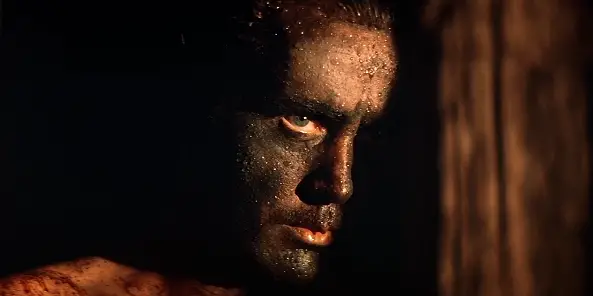
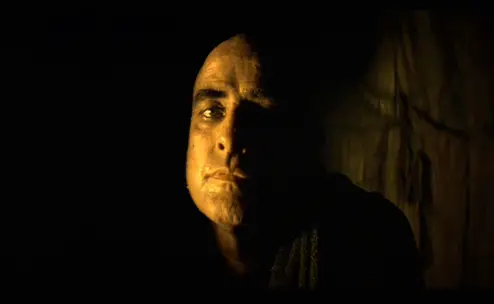
This duality of lightness and darkness hangs over the entire film, as Coppola offers paradox after paradox, most notably Brando’s line, “We teach the boys to drop fire on people, and yet we won’t let them write the word ‘fuck’ on their airplanes.” When you understand Coppola’s artistic sensibilities, you come to understand that the half-lit faces of lightness and darkness represent our internal choice as people — and as a nation — between the “hawk” and the “dove,” an eternal battle of gungho military adventurism versus anti-war peacemaking.
Hawks. The gungho military hawk will present Vietnam as a necessary battle to prevent the spread of Communism across Asia, yet one that went off the rails because it was horribly mismanaged. This point of view would suggest that Americans could have won the war if they ran a tighter ship, as expressed in Milius’ voiceover narration: “Charlie didn’t get much USO … The war was being run by a bunch of four-star clowns who were gonna end up giving the whole circus away.” Audiences with this perspective will cheer the “shock and awe” of the U.S. helicopter raid on a Vietnamese village, with helicopters blaring Wagner’s “Ride of the Valkyries.” In fact, U.S. military forces replicated this scene during Desert Storm and the Iraq War, as captured in Sam Mendes’ Jarhead (2003). But note also that the KKK rode into “Ride of the Valkyries” in The Birth of a Nation (1915).
Doves. Upon closer examination, however, we see Coppola’s anti-war subversiveness. Note how Duvall’s character is named Colonel Kilgore, as in “kill gore.” Note how Brando shows Sheen a series of newspaper and magazine clippings, symbolizing how politicians can selectively show propaganda to support their own agenda, as in the Gulf of Tonkin? Note the tragic ironies, like during the funeral of Mr. Clean (Laurence Fishburne), when a black man hands Sheen a folded flag and says, “For a country who appreciates it.”
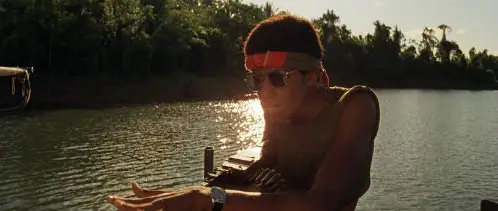
Perhaps most important to Coppola’s anti-war message is the scene where Willard’s patrol boat comes upon a French Plantation, where a Frenchman complains that protestors back home are sabotaging any chances of winning the war. Remember, Vietnam began as a French colony, much like the U.S. was for Great Britain. It was the Vietnamese revolt for independence against the French (fueled by a communist strain) that triggered the war. Coppola comments on history with a unique approach, suggesting that the further they go down the river, they further they go back in time, into the fog, to meet the ghosts of wars past, like seeing the remnants of a star, only light years after the star has burned out. (A)
This plantation scene went unseen for decades, until the 2001 release of the director’s cut, Apocalypse Now Redux. This is a shame, as I still maintain this 20-minute stretch (appearing two hours into the Redux cut) is the most important scene at making sense of Coppola’s theme amid the chaos of insanity. As Willard sits at the dinner table with the Frenchmen, the dinner conversation insists that America invented the Vietcong after WWII, similar to America’s creation of The Taliban during the Soviet War in Afghanistan (1979-1989) — the subject of Charlie Wilson’s War (2007). A character also insists that the Vietnamese hated the Russians and the Chinese, providing a clear separation of the terms “communist” and “socialist.” We also get a history lesson on Dien Bien Phu, that the French Army, who didn’t stand a chance, was sacrificed by politicians who were safe at home in Paris, just like American troops sacrificed in Vietnam by politicians safe at home in Washington. There’s a large message of learning from the past, as a Frenchman says from experience, “You Americans, you are fighting for the biggest nothing in history.”
This French Plantation sequence ends with a French woman’s assertion that within all people, there are two sides: “There are two of you, don’t you see? One that kills, and one that loves.”
The crossing-over point between “the kind that loves” and “the kind that kills” lies at Do Lung Bridge, a.k.a. the “asshole of the world,” the final U.S. outpost before Kurtz’s compound. The film describes this bridge as The Gates of Hell, where soldiers cry, “Who’s in charge?” with the only answer being Satan, posing war as the exact opposite of “God’s work,” a point that so often is confused, whether it’s Christians on Crusades or Muslims on Jihad. For Coppola, this “crossing over” point marks the transition from the authentic reality of war to the insanity of it, with his style shifting to surrealism for the rest of the movie, marked by psychedelic music, pyrotechnic neon colors and an ever-billowing fog. It’s no wonder that Apocalypse Now is the favorite movie of Danny Boyle, director of the ultimate drug movie Trainspotting (1996).
Once Willard arrives at Kurtz’s compound, all bets are off. We need no further proof than the wacky photojournalist who welcomes them, played by the drugged-out Dennis Hopper. Note how he says, “You can’t talk to the colonel,” as if Kurtz has become Oz: the Great and Powerful. He is their “Master,” like Philip Seymour Hoffman to Joaquin Phoenix in The Master (2012). Or, if you’d like a real-world example, consider the horrors of Jim Jones, who convinced his religious followers to travel with him to Guyana to create their own city of Jonestown, where he led 918 people in a murder-suicide by “drinking the Kool-Aid” on November 18, 1978, while Apocalypse Now was still in production.
As we continue Hopper’s worship of Brando’s Kurtz, we’re shown the giant face of Kurtz carved into the mountain like Mount Rushmore. This image appears superimposed over the screen next to Sheen’s face during the opening and closing as two sides of the same coin. Hopper reinforces the aforementioned duality, saying, “That’s dialectic physics, okay? Dialectic logic is that there is only love and hate. You either love somebody, or you hate them.”
We get further insight into Kurtz’s mind in Brando’s famous monologue:
KURTZ: “I’ve seen horrors… horrors that you’ve seen. But you have no right to call me a murderer. You have a right to kill me. You have a right to do that… but you have no right to judge me. It’s impossible for words to describe what is necessary to those who do not know what horror means. Horror… Horror has a face… and you must make a friend of horror. Horror and moral terror are your friends. If they are not, then they are enemies to be feared. They are truly enemies! I remember when I was with Special Forces… seems a thousand centuries ago. We went into a camp to inoculate some children. We left the camp after we had inoculated the children for polio, and this old man came running after us and he was crying. He couldn’t see. We went back there, and they had come and hacked off every inoculated arm. There they were in a pile. A pile of little arms. And I remember… I… I… I cried, I wept like some grandmother. I wanted to tear my teeth out; I didn’t know what I wanted to do! And I want to remember it. I never want to forget it… I never want to forget. And then I realized… like I was shot… like I was shot with a diamond… a diamond bullet right through my forehead. And I thought, my God… the genius of that! The genius! The will to do that! Perfect, genuine, complete, crystalline, pure. And then I realized they were stronger than we, because they could stand that these were not monsters, these were men… trained cadres. These men who fought with their hearts, who had families, who had children, who were filled with love… but they had the strength… the strength… to do that. If I had ten divisions of those men, our troubles here would be over very quickly. You have to have men who are moral… and at the same time who are able to utilize their primordial instincts to kill without feeling… without passion… without judgment… without judgment! Because it’s judgment that defeats us.”
At this point, Colonel Kurtz has secretly begged Willard to kill him, saying, “You have a right to kill me. You have a right to do that… but you have no right to judge me.” There is no other way for this story to end than for Willard to complete his mission and exterminate Kurtz “with extreme prejudice.” While lesser filmmakers would have shown Willard savagely chop Kurtz with CGI blood flying, Coppola gives us a beautifully artistic allegory with the slaughter of a caribou — an idea suggested by Coppola’s wife. The notion recalls a scene from the silent film Strike (1925), where Sergei Eisenstein metaphorically cut between: (a) a group of workers running from soldiers, and (b) a bull being slaughtered. Coppola takes this technique a step further, intercutting the literal hacking of Curtz with the literal hacking of the caribou.
![]()
Ambiguity & Legacy
As Willard slays Kurtz and steps out among the people as their new “god,” the film comes to a conclusion that will no doubt divide audiences. Some viewers will pull their hair out trying to make sense of a frustratingly ambiguous ending, a mixture of amputated heads, Hopper’s stoned logic, Brando’s mumbling rants and a Caribou sacrifice set to Jim Morrison’s screams. This is exactly the reason why many mainstreamers loathe Apocalypse Now, digging the adventure premise and poetic narration, but become lost in the bloated runtime and ambiguous ending.
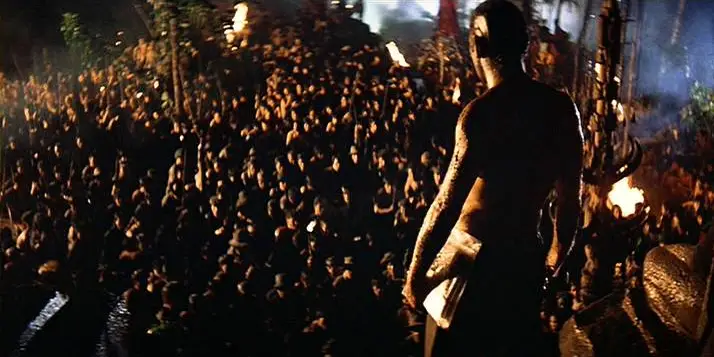
However, I insist it’s worth it. If you’d like a guidepost into one of the most complex movie experiences there is, you should remember the words, “There are two of you, one that kills and one that loves,” and connect it to a speech given to Willard as he is briefed on the mission: “In this war, things get confused out there. Power, ideals, the old morality and practical military necessity. But out there with these natives, it must be a temptation to be God. Because there’s a conflict in every human heart, between the rational and the irrational, between good and evil, and good does not always triumph.”
The same can be said of cinema — there is a conflict in every film’s heart, between the rational and the irrational, and the rational does not always triumph, as in the end of Apocalypse. As Milius joked, “People should go back and read the original reviews of Apocalypse Now, because there are no good ones.” Coppola agreed: “Young filmmakers especially, what I want them to get out of it is that these movies come out and they be considered failures at first, but the real sign of greatness in a movie is if people will still look at it in 40 years, not what one the Oscar that year.”
Indeed, Apocalypse Now lost the Oscar for Best Picture to Kramer vs. Kramer (1979), a film that was safer for mainstream audiences. But it did pick up the Palme d’or at the Cannes Film Festival by scholars who grew up on the French New Wave and craved deeper meanings rather than tidy endings. Fittingly, you’ll notice that Kramer vs. Kramer is nowhere to be found in the AFI Top 100 Films, while Apocalypse Now ranks very high. Scholar David Thomson insists that the film’s legacy has been aided tremendously by the Redux director’s cut, saying that the initial release was a mess, but that further releases have revealed it as a masterpiece of cinema.
“Francis works in a very intuitious way, so he likes to take advantage of things as he moves along through a picture,” said George Lucas, who was originally going to direct Apocalypse. “Francis just likes it to flow, and whenever you do that, you end up with a problem of having a film at times that is way too long and a film that doesn’t have a really strong narrative line in it that you can keep the audience hooked in.”
Perhaps this ambiguity is indeed a flaw, but Coppola at least calls himself on it. Act Three is absolutely a chaotic burst of experimental filmmaking, but Coppola counters his critics by having Brando rant about “Shape without form.” More importantly, Brando asks, “Are my methods unsound?” Sheen replies, “I don’t see any method at all, sir.”
Is there a method to Coppola’s madness? I hope that the above analysis will provide you the answer. But in the end, like any movie, it’s up to each individual viewer to decide whether Coppola created a transcendent masterpiece or an incoherent ramble. It’s up for you to decide whether Apocalypse Now toes the tightrope of The Film Spectrum, or whether Coppola’s worst fears are realized:
“Nothing is so terrible as a pretentious movie, a movie that aspires for something really terrific and doesn’t pull it off is shit, it’s scum, and everyone will walk on it as such. And thats why poor filmmakers, in a way, that’s their greatest horror, is to be pretentious. So here you are on the one hand, to try to aspire to really do something, on the other hand you’re not allowed to be pretentious. Why don’t you say fuck it, I don’t care if I’m pretentious or not pretentious or if I’ve done it or haven’t done it, all i know is that I’m gonna see this movie, and that for me it has to have some kind of answers, and by answers i don’t mean just a punchline, but answers on about 47 different levels, and it’s very hard to talk about these things without sounding corny, you use a word like self-purgatrion or epiphany, they think you’re either some kind of religious weirdo or asshole college professor, but those are the words for the process, this transmutation, this renaissance, this rebirth, which is the basis of all life.”
![]()
Citations:
CITE A: Hearts of Darkness: A Filmmakers Apocalypse (1991)
CITE B: AFI Top 100: 10th Anniversary Edition
